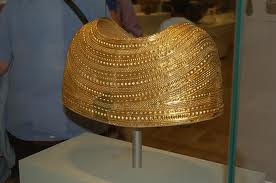Brief History of Wales
In 1282, the murder of Llywelyn the Last of Wales led to the conquest of Wales by King Edward I of England; afterwards, the heir apparent to the English monarch has borne the title "Prince of Wales". The Welsh launched several revolts against English rule, the last significant one being that led by Owain Glyndŵr in the early 15th century. In the 16th century Henry VIII, passed the Laws in Wales Acts aiming to fully incorporate Wales into the Kingdom of England. Under England's authority, Wales became part of the Kingdom of Great Britain in 1707 and then the United Kingdom in 1801.
Welsh Treasures
Gold Cape of MoldWorkmen quarrying for stone in an ancient burial mound in 1833 found this unique ceremonial gold cape, which remains unparalleled to this day. The mound lay in a field named Bryn yr Ellyllon (the Fairies' or Goblins' Hill). It was found at Mold in Flintshire, Wales, in 1833. The Mold Cape is a solid sheet-gold object dating from about 1900-1600 BC in the European Bronze Age. The cape is one of the finest examples of prehistoric sheet-gold working and is quite unique in form and design. It was laboriously beaten out of a single ingot of gold, then embellished with intense decoration of ribs and bosses to mimic multiple strings of beads amid folds of cloth. It is not known who wore the cape but it could only fit a slim woman or child. Whoever wore it must also have possessed great power and wealth. This wealth may have been generated by the nearby Great Orme - the largest copper mine in north-west Europe. This would have been a major trading centre for prehistoric communities.The fragile cape broke up during recovery and the pieces were dispersed among various people. Although the British Museum acquired the greater proportion in 1836, small fragments have come to light over the years and have been reunited. Rhaeadr Gwy/Rhyader TreasureOn 26th May 1899 a hoard of Roman and late Celtic treasure was accidentally found on Gwastedyn Hill near the Rhayader area of Powys by a local man from Cwmdeuddwr called James Marston. The Sheriff was informed who told the British Museum and a coroner’s inquest was held in Rhaeadr. The inquest reported that there was one gold ring set with onyx and engraved on the setting an ant, a portion of a gold necklet of nine pieces (eight links set with stones and one stone with the link missing), one piece of gold scroll, a small piece of embossed gold (both forming part of the necklet) and a gold armlet in four pieces. The grand daughter of James Marston says that after the inquest the treasure "was whipped away with undue haste" in 1899 to the British Museum in London, where it is still held.
|
 The reconstructed gold cape, which was beaten out of a single ingot. |